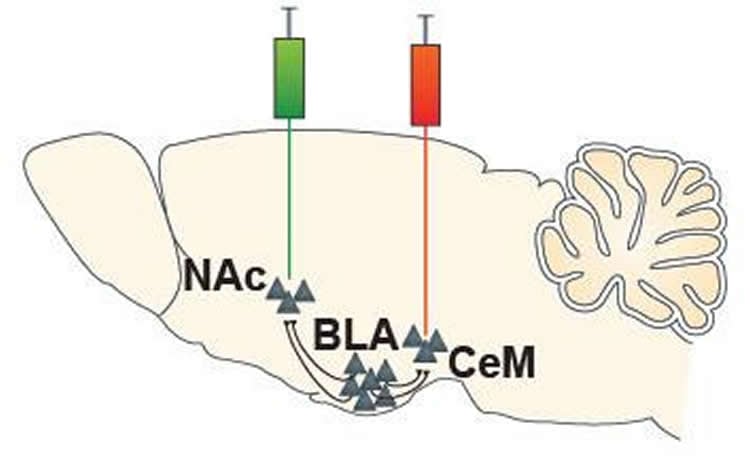Push-pull control cinches causal connection.
Neuroscientists have discovered brain circuitry for encoding positive and negative learned associations in mice. After finding that two circuits showed opposite activity following fear and reward learning, the researchers proved that this divergent activity causes either avoidance or reward-driven behaviors. Funded by the National Institutes of Health, they used cutting-edge optical-genetic tools to pinpoint these mechanisms critical to survival, which are also implicated in mental illness.
“This study exemplifies the power of new molecular tools that can push and pull on the same circuit to see what drives behavior,” explained Thomas R. Insel, M.D., director of NIH’s National Institute of Mental Health (NIMH). “Improved understanding of how such emotional memory works holds promise for solving mysteries of brain circuit disorders in which these mechanisms are disrupted.”
NIMH grantee Kay Tye, Ph.D., Praneeth Namburi and Anna Beyeler, Ph.D., of the Massachusetts Institute of Technology (MIT), Cambridge MA, and colleagues, report their findings April 29, 2015 in the journal Nature.

Prior to the new study, scientists suspected involvement of the circuits ultimately implicated, but were stumped by a seeming paradox. A crossroads of convergent circuits in an emotion hub deep in the brain, the basolateral amygdala, seem to be involved in both fear and reward learning, but how one brain region could orchestrate such opposing behaviors – approach and avoidance – remained an enigma. How might signals find the appropriate path to follow at this fork in the road?
To find out, Tye and colleagues explored whether two suspect circuit projections from the crossroads might hold clues. One projects to a reward center, the nucleus accumbens, and the other to a nearby fear center, the centromedial amygdala, the output station of the emotion hub.
Each circuit projection is composed of separate populations of intertwined neurons. The researchers first used telltale fluorescent bead tracers to sort out which neurons belonged to each circuit. They then measured an indicator of connectivity – the strength of neural connections – in the projections, after mice underwent fear or reward learning. Animals were trained to either fear a tone paired with a shock or to associate the tone with a sugar reward.
Strikingly, crossroads connectivity to reward center projections decreased after fear learning and increased with reward learning. By contrast, connectivity to fear center projections increased with fear learning and decreased after reward learning.
These converging mechanisms in anatomically intertwined circuits could hold clues to teasing apart how positive and negative emotional associations may influence each other, Tye suggested.
To prove a causal link between the projection-identified circuits and behavior, Tye’s team turned to optogenetics, which enables light pulses to control brain circuitry in animals genetically engineered to be light-responsive. Optically stimulating the reward center projection enhanced positive reinforcement, while stimulating the fear center projection promoted negative reinforcement. Similarly, blocking the fear center projection impaired fear learning and enhanced reward learning.

Finally, the researchers pinpointed defining electrophysiological, anatomic and genetic features of the two circuits that help to explain the opposite connectivity responses.
“Given that many mental health problems, including anxiety, addiction, and depression, may arise from perturbations in emotional processing, these findings could help to pave the way to a circuit-based approach to treating mental illness,” said Tye.
Funding: The research was funded by the NIH/National Institute of Mental Health.
Source: Jules Asher – NIH/NIMH
Image Credit: The images are credited to Praneeth Namburi, Anna Beyeler, Ph.D., Kay M. Tye, Ph.D., Massachusetts Institute of Technology
Original Research: Abstract for “A circuit mechanism for differentiating positive and negative associations” by Praneeth Namburi, Anna Beyeler, Suzuko Yorozu, Gwendolyn G. Calhoon, Sarah A. Halbert, Romy Wichmann, Stephanie S. Holden, Kim L. Mertens, Melodi Anahtar, Ada C. Felix-Ortiz, Ian R. Wickersham, Jesse M. Gray and Kay M. Tye in Nature. Published online April 30 2015 doi:10.1038/nature14366
Abstract
A circuit mechanism for differentiating positive and negative associations
The ability to differentiate stimuli predicting positive or negative outcomes is critical for survival, and perturbations of emotional processing underlie many psychiatric disease states. Synaptic plasticity in the basolateral amygdala complex (BLA) mediates the acquisition of associative memories, both positive1, 2 and negative3, 4, 5, 6, 7. Different populations of BLA neurons may encode fearful or rewarding associations8, 9, 10, but the identifying features of these populations and the synaptic mechanisms of differentiating positive and negative emotional valence have remained unknown. Here we show that BLA neurons projecting to the nucleus accumbens (NAc projectors) or the centromedial amygdala (CeM projectors) undergo opposing synaptic changes following fear or reward conditioning. We find that photostimulation of NAc projectors supports positive reinforcement while photostimulation of CeM projectors mediates negative reinforcement. Photoinhibition of CeM projectors impairs fear conditioning and enhances reward conditioning. We characterize these functionally distinct neuronal populations by comparing their electrophysiological, morphological and genetic features. Overall, we provide a mechanistic explanation for the representation of positive and negative associations within the amygdala.
“A circuit mechanism for differentiating positive and negative associations” by Praneeth Namburi, Anna Beyeler, Suzuko Yorozu, Gwendolyn G. Calhoon, Sarah A. Halbert, Romy Wichmann, Stephanie S. Holden, Kim L. Mertens, Melodi Anahtar, Ada C. Felix-Ortiz, Ian R. Wickersham, Jesse M. Gray and Kay M. Tye in Nature. Published online April 30 2015 doi:10.1038/nature14366






